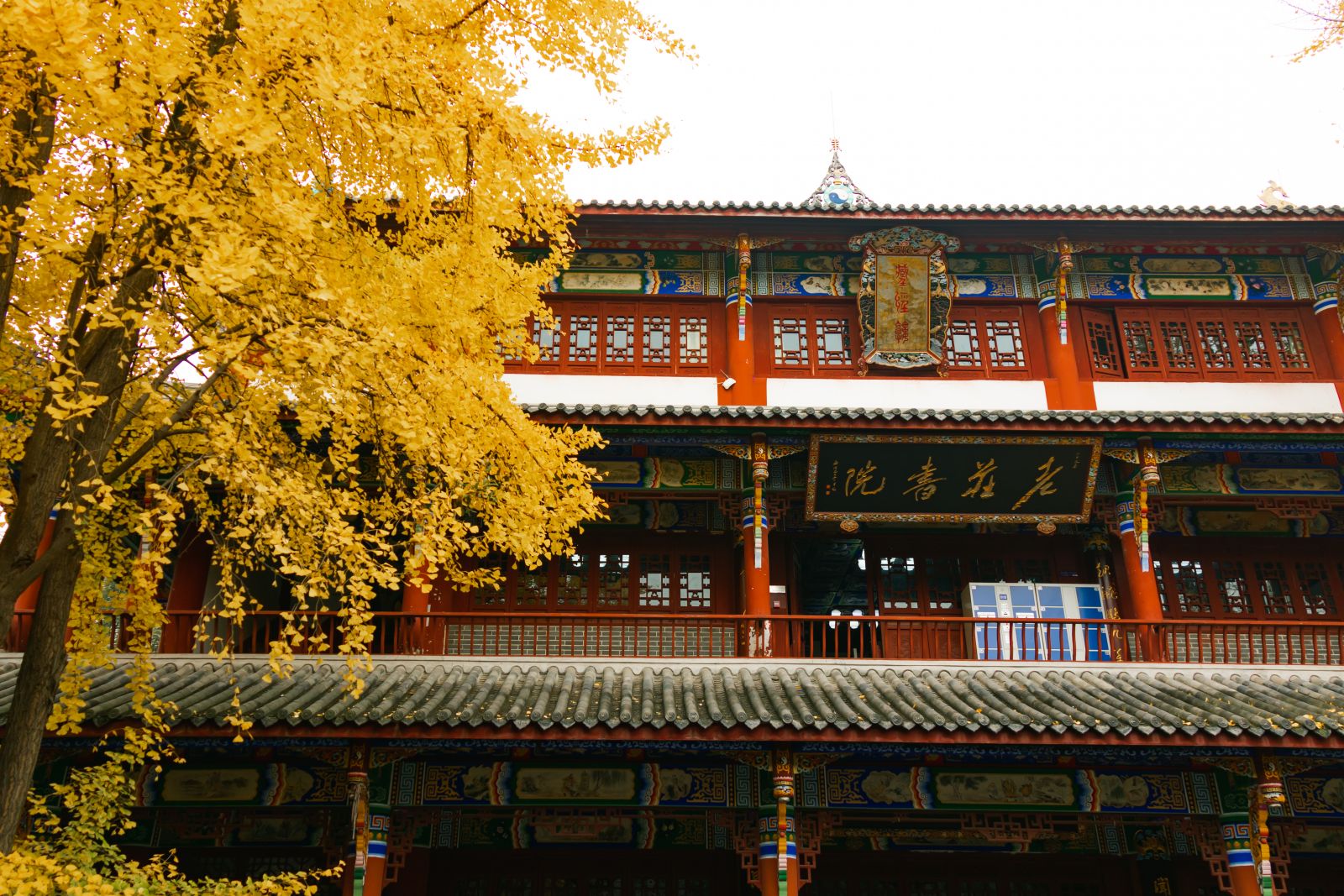Chinese Name: 青羊宫 Pronunciation: Qīngyáng Gōng
Service Time: 8: 00-18: 00
Occupied Area: 120, 000 square meters
Suggested Visiting Hours: 1-2 Hours
Best Visiting Seasons: All Seasons
Building Time: In the Zhou Dynasty (1046 BC - 249 BC)
Address: No. 9, West Section 2, First Ring Road, Qingyang District, Chengdu City, Sichuan Province, China
| Tourists | Price |
| Adults | 10 yuan |
| Students | 5 yuan |
1. Children shorter than 1.2 meters are free of charge.
2. Senior citizens over 60 years old are free of charge.
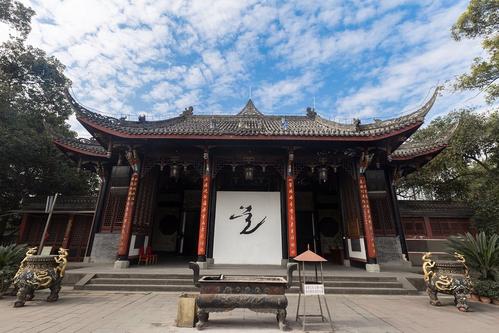
Qingyang Palace is also known as Green Ram Temple, Bronze Goat Taoist Temple, or Qingyang Taoist Temple. It is located on West Section 2 of the First Ring Road, Chengdu, Sichuan, by the beautiful Jinjiang River. Qingyang Palace has been famed as the “No. 1 Taoist Temple in West Sichuan”.
First built in the Zhou Dynasty and then destroyed, Qingyang Palace was rebuilt in the Tang Dynasty (618 - 907), a time of flourishing Taoist influence. Later in the Qing Dynasty (1644 - 1912), people repaired the Main Gate, the Hunyuan Hall and the Eight Trigram (Bagua) Pavilion, and other buildings, forming an entire palace complex with various styles.
In the first year (881) of the Zhonghe reign, the Tang emperor retreated to Chengdu to avoid the Huang Chao Uprising. With great thanks for the sanctuary at Qingyang Palace, the emperor financed the construction of shrines and halls, and changed its original name, Qingyang Si to Qingyang Gong (Qingyang Palace) in 883. During the Ming Dynasty, the temple buildings constructed in the Tang Dynasty were badly destroyed by natural calamities and wars.
Today’s buildings at Qingyang Palace are the results of the successive reconstructions from the sixth to the tenth year (1667 - 1671) of the Kangxi reign of the Qing Dynasty.
Qingyang Palace is a large-scale temple complex and is a famous Taoist temple, with the cultural relics including the Hall of Goddess Doumu, the Eight Trigram Pavilion, the copper green ram, the stone carving of the Immortal Lv Dongbin drawn by Wu Daozi, a stele of Master Zhang Sanfeng, and the precious pearwood scripture plates of The Essence of Taoist Canon (Dao Zang Ji Yao).
In the Zhou Dynasty, Qingyang Palace was built with the original name Qingyang Si in Chinese.
During the Huang Chao Uprising in 881, Emperor Xizong of the Tang Dynasty took refuge here at the temple.
In 883, this temple was renamed Qingyang Palace.
From 907 to 960, it was known as Qingyang Guan (Qingyag Taoist Temple), and in the Song Dynasty, it was renamed Qingyang Palace until today.
After the Reform and Opening Up, it has been repaired many times.
In 1984, the Taoist Zhang Yuanhe of Qingyang Palace agreed with the Sichuan Bashu Publishing House to reprint Dao Zang Ji Yao (The Essence of Taoist Canon). This has allowed the reprint and issuance of Dao Zang Ji Yao, China’s only surviving carved edition of the Taoist classic in the Qing Dynasty.
On April 9, 1983, Qingyang Palace was designated by the State Council as a National Key Taoist Temple in the Han region.
On December 27, 2002, Qingyang Palace also became one of the Key Cultural Protected Units in Sichuan.
On June 10, 2004, the copper ram donated by Zhang Penghe, a prime minister of the Qing Dynasty, has been treasured as a cultural relic for protection in Qingyang Palace. The duplicate copper cram was unveiled at 10:30 am on June 9, 2004.
Qingyang Palace originally occupied an area of 100,000 square meters, and in the early Qing Dynasty, the area increased to more than 200,000 square meters. The existing buildings have a construction area of 4,800 square meters. Divided into six layers and built on a central axis, the main buildings of Qingyang Palace includes the Main Gate, the Hunyuan Hall, the Eight Trigram Pavilion, the Hall of Three Purities, the Hall of Goddess Doumu, the Jiangsheng Platform, the Shuofa Platform, and the Zijin Terrace. The wall on the west side of the Main Gate is called Bazi Wall, 20 meters long and 4 meters high.
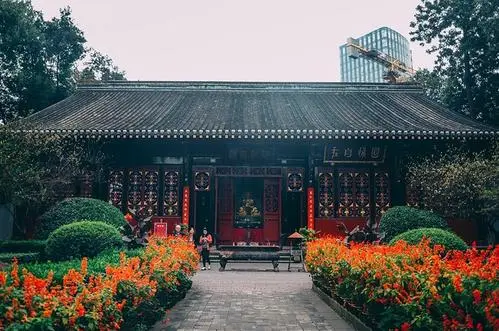
The first hall of Qingyang Palace is the Lingzu Hall, which covers an area of 400 square meters and is 20 meters high. The top of wall is covered with glazed tiles, in shape of white petals on the sides and red glazed lotus flowers at the center. On the right side of the hall, there are statues of the Land God and a blue dragon, and the Nine-dragon Monument of Emperor’s Grace set up in the 12th year (1517) of Zhengde reign of the Ming Dynasty.
The Eight Trigram Pavilion is located between the Hall of Three Purities and the Hunyuan Hall. The stone base of the pavilion is divided into three layers of different shapes, square, octagonal, and round respectively. This kind of layout is to fit the Taoist heaven and earth, seek harmony between Yin and Yang, and coincide with the eight hexagrams.
Behind the Hall of Three Purities is the only existing original building of the Ming Dynasty in Qingyang Palace, the Hall of Goddess Doumu. It is an all-wood building.
The last group of the symbolic buildings in the Qingyang Palace includes the Jiangsheng Platform on the left, the Shuofa Platform on the right, and the Zijin Terrace (also known as “Tangwang Palace” with statues of the first two emperors of the Tang Dynasty, Li Yuan and Li Shimin) in the middle.
You can see the Main Gate at the moment that you first get close to Qingyang Palace. On the left side of the Main Gate, there are statues of the Land God and a blue dragon. There is also the Nine-dragon Monument of Emperor’s Grace built in the Ming Dynasty.
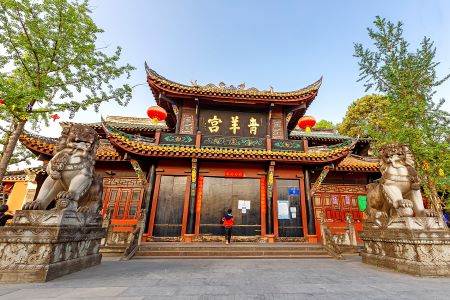
On the right, there is a statue of a white tiger and the seven-star piles which are engraved with the Taoist sacred texts. According to the layout of the Big Dipper, the piles are also called the Big Dipper Piles. There are also Dragon and Phoenix Piles, a pair of huge stone lions, and the Dragon King Well.
The newly built gate is solemn and magnificent with overlapping cornices. The auspicious animal carvings of dragons and tigers are inlaid on the cornices, with meticulous carving skills and elegant shapes. There are two dragons on the top of the palace playing with a ball.
The plaque with three golden Chinese characters “Qing Yang Gong” (Qingyang Palace) hangs high above the gate. This plaque was the calligraphy of An Hongde, the magistrate of Huayang County in Chengdu during the Qianlong period of the Qing Dynasty. The Main Gate is also the first building you can appreciate in Qingyang Palace.
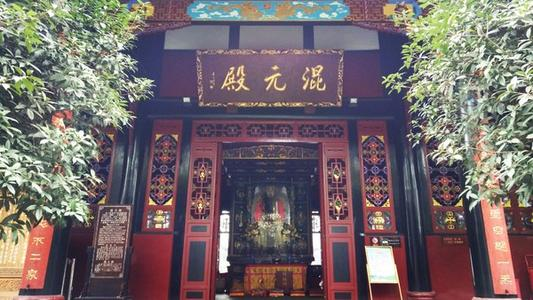
The Hunyuan Hall was rebuilt during Emperor Guangxu’s reign (1875-1908) in the Qing Dynasty. The hall is the second major hall of Qingyang Palace. It is about 22 meters high supported by 28 stone columns, and covers an area of about 600 square meters.
Enshrined in the hall is a statue of the Patriarch of Original Chaos (or Taishang Laojun, the Supreme Venerable Sovereign) and Immortal Cihang (or the Goddess of Great Compassion), one of the 12 Taoist Golden Immortals. The Patriarch of Original Chaos in the hall has a kind face, holding the Hunyuan Universe Circle. The rear chamber is dedicated to Immortal Cihang, which is called “Guanyin” in Buddhism.
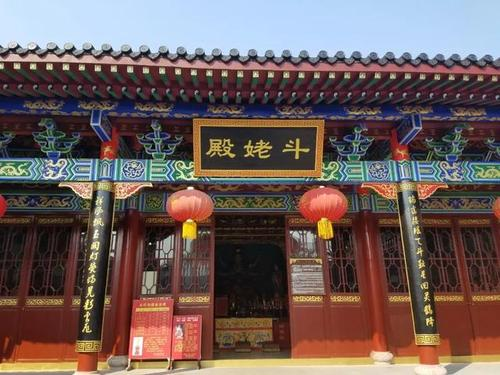
The Hall of Goddess Doumu, also called Yuanchen Hall, is about ten meters long and nine meters wide. The completely wooden-structured Hall of Goddess Doumu was built in the Ming Dynasty. It is the unique architecture of the Ming Dynasty preserved at Qingyang Palace.
Legend has it that Goddess Doumu is in charge of the life and death of people. Enshrined in the hall is the statue of the four-headed and eight-armed Goddess Doumu, with a statue of the Supreme Goddess of Earth on the left, the Queen Mother of the West on the right, and the seven stars of the Big Dipper, the six stars of the Southern Dipper, and the statue of the South Pole Sovereign of Longevity on both sides.

The Hall of Three Purities or Wuji Hall is the main hall of Qingyang Palace, and it was first built in the early years of the Tang Dynasty and rebuilt in the 8th year (1669) during the reign of Emperor Kangxi in the Qing Dynasty, which covers an area of about 1,600 square meters in total.
Enshrined midmost are the icons of the supreme Taoist lords, the Three Purities (San Qing). In the middle is the Heavenly Honored Primordial Beginning (Great Emperor of the Jade Purity, Yuqing Yuanshi Tianzun in Chinese), on its left is the Heavenly Honored Numinous Treasure (Great Emperor of the Highest Purity, Shangqing Lingbao Tianzun in Chinese) and on its right is the Heavenly Honored Virtue (Great Emperor of the Greatest Purity, Taiqing Daode Tianzun in Chinese).
Enshrined on the two sides are the statues of 12 Golden Immortals. Precious Taoist cultural relics, including the single-horned copper ram, the World of Darkness Bell, a stele of the Immortal Lv Dongbin, a stele of Master Zhang Sanfeng, and the ghost money burner forged in the Ming Dynasty are also housed in the hall.
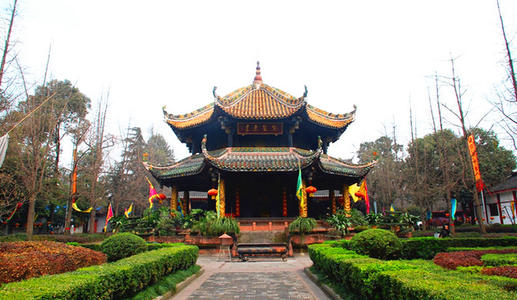
The Eight Trigram Pavilion is located between the Hall of Three Purities and the Hunyuan Hall. It is the most complete and luxurious building in Qingyang Palace. Among them, the statue of Laozi riding an ox is enshrined in it, which is a landmark building that prominently embodies the teachings of Taoism.
The three-floored building is about 20 meters high and 17 meters wide, and it covers an area of nearly 300 square meters. It has a neat layout, which looks exquisite and generous.
The Eight Trigram Pavilion features a square foundation and a cylindrical body symbolizing the ancient Chinese theory of “a square earth and spherical heaven”. The south-facing main entrance is a relief sculpture of the twelve zodiac signs of Tai Chi (Taiji), which looks elegant. The entire pavilion is made of wood and stone, and they are connected by tenon joints without a single wedge or bolt.
The upper two layers of the Eight Trigram Pavilion’s stone railings are octagonal. Each layer of the pavilion’s cornices is decorated with lions, elephants, tigers, and leopards. The roof is made of yellow, green, and purple glazed tiles. The lotus petals on the roof set off the unique glazed gourd tripod very well. It is about 3.6 meters high and has a beautiful and spectacular shape.
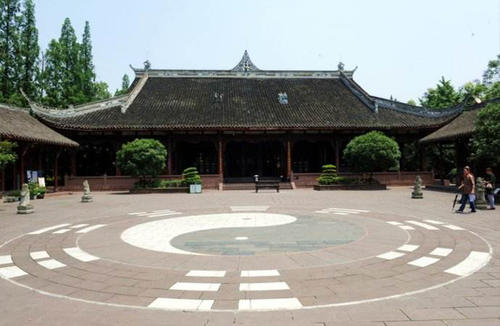
There are 16 columns made of giant rocks, about 4.8 meters high and 0.5 meters in diameter. There are 8 columns with flying dragons, carved with the technique of relief combined with hollow-out, which is one of the rare stone carving techniques.
There is also a myth in the Eight Trigram Pavilion. It is said that on the eve of its completion, the circling dragon on the stone pillar facing the Hall of Three Purities was about to come alive and fly away, and it was discovered by the envoy of the Moon Imperial Duty. The envoy immediately fastened the dragon on the pillar with his fist. On the pillar, the fist mark remains on the top of the pillar.
The two Chinese characters Qingyang literally means green ram. According to the records on the “Reconstruction of the Qingyang Palace Stele” in the early years of Kangxi’s reign in the Qing Dynasty, Laozi, the great Chinese philosopher, rode a green ram through Hangu Pass, and gave lectures on Dao De Jing (Tao Te Ching, a classic of Chinese philosophical literature of Laozi) to Yinxi, the guardian of the pass. Halfway through, Laozi had to leave and said to Yinxi, “After you have propagandized your own political opinions for one thousand days, you’d better come to Qingyang Palace in Chengdu to find me.”
About one thousand days later, Yinxi came here as told and Laozi continued to teach Yinxi. Therefore, people thought that the two words “Qing Yang” were related to the establishment of Taoism in the Han Dynasty and the founder.
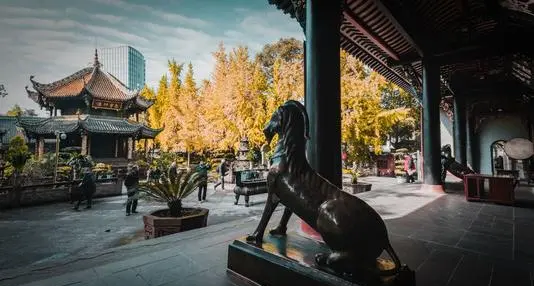
What was Qingyang Palace like in the Han Dynasty? People today have no way of knowing whether there was any ram at Qingyang Palace. The pair of bronze rams stored in the temple today is not the relics of the Han Dynasty. One of them was related to Zhang Penghe, a native of today’s Suining City of Sichuan Province, who worked in Beijing during the Yongzheng period of the Qing Dynasty. He saw an “old and precious” bronze ram in the street one day, and he bought it and then brought it back to Qingyang Palace in Chengdu. Zhang Penghe knew that actually there was no ram at Qingyang Palace, so he bought the ram to decorate the temple.
According to legend, since the arrival of the bronze ram at Qingyang Palace, more and more Taoist believers made Qingyang Palace, which was already somewhat famous, more famous. In the ninth year (1829) of Daoguang in the Qing Dynasty, a coppersmith in Yunnan cast a two-horned copper ram specially, which is almost the same size as the original one. Therefore, there are two bronze rams on both sides in front of the Hall of Three Purities.
It was said that the people in Sichuan liked exciting things. Due to the two strange objects at Qingyang Palace, people rumored that the ram the founding father of Taoism rode had turned into a bronze ram or even a gold ram. And then local people in Chengdu and people from other counties in Sichuan came to worship. Some rumors also said all diseases could be easily cured and the pain could be relieved. Others even said once you touched the ram, there would be no pain in your body anymore. All these rumors made Qingyang Palace crowded every day.
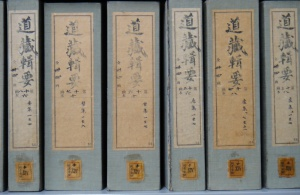
The wooden engraved Dao Zang Ji Yao (The Essence of Taoist Canon) is one of the most valuable Taoist relics. The edition engraved in the 32nd year (1906) of Emperor Guangxu’s reign in the Qing Dynasty is preserved in the temple. In 1984, Chengdu Taoism Association and Bashu Publishing House jointly reprinted Dao Zang Ji Yao, which is a precious historical material for studying Taoism at home and abroad.
This volume contains more than 13,000 pieces of two-sided wooden engravings. The handwriting is neat and tidy. Dao Zang Ji Yao is the most comprehensive preservation of Chinese Taoist classics, and it is a precious Taoist historical relic.
The 15th day of the second lunar month is not only the day for the historic Flower Fair of Qingyang Palace but also the day for the traditional temple fair. On this day, people are not only ready to celebrate the birthday of Laozi but the birthday of flowers. Since the Tang Dynasty, folks have held temple fairs here annually, which combines the temple fair and the flower market into one feast, and the scale has gradually expanded, making Chengdu livelier and more bustling.
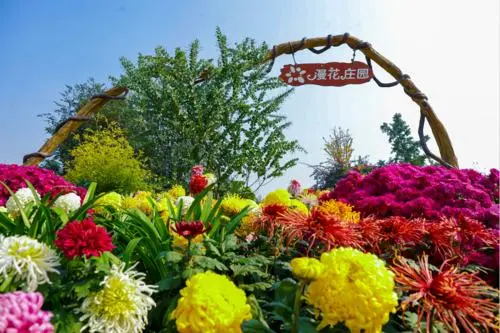
On the day of the festival, the palace is filled with fragrance, and it is very crowded. All kinds of famous flowers outside the palace are vying for beauty.
Chengdu has been known as a famous flower city in ancient times, and its history can be traced back to the Tang and Song Dynasties. According to traditional customs, people generally set the days around the flower festival as the “Flower Market” in Chengdu. The flower fairs and temple fairs in Qingyang Palace of Chengdu boast a history of more than a thousand years since they were popular in the Tang and Song Dynasties.
The Laba Festival has a long history in China and is a traditional Chinese sacrificial occasion to ancestors. Making and eating Laba porridge on the eighth day of the twelfth month of the lunar calendar is the most traditional custom for people all over the country. The twelfth lunar month is also known as “La month” and the number eight is pronounced as “Ba” in Chinese, So the porridge is called Laba porridge or eight-treasure porridge.
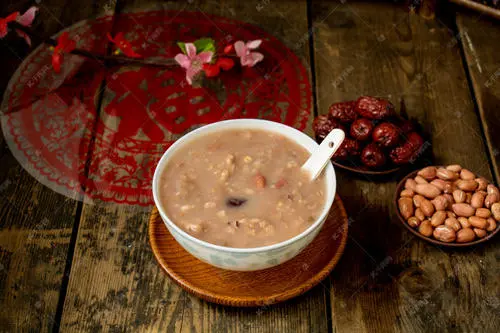
The eight-treasure porridge is a symbol of blessing and auspicious wishes for people. All of the believers and tourists pray that the motherland will be prosperous, the grains will be abundant, and the people will be healthy.
Qingyang Palace conducts a large-scale porridge-making activity on the Laba Day every year. Handing out the free porridge aims to strengthen cultural confidence and adhere to Taoism. Qingyang Palace has collected more than a dozen of authentic health ingredients to make the eight-treasure porridge and prepared them carefully.
With the strong support of warm-hearted people here, sweet, delicious, and nutritious eight-treasure porridge will be made and distributed at Qingyang Palace during the Laba Festival so that it always attracts nearly 10,000 citizens to taste it. Whether aged citizens or children, rich or poor, Chinese or foreign tourists, all will give thumbs up to the porridge and eat happily.
How is the eight-treasure porridge or Laba porridge made in Sichuan, especially the welcome received one at Qingyang Palace? Its ingredients include a nutritious mix of glutinous rice, red beans, and peanuts in most regions in China. While in Sichuan, the method is different from other regions and the specific steps are as follows.
Ingredients:
right amount of rice, 2 carrots, 2 dried smoked Tofu pieces, 1 green bamboo shoot, 7 to 10 shiitake mushrooms, a little fungus, half a catty of pork filling, 5 to 8 shrimps.
Production Method:
1. Wash the rice and then put it in a casserole, add water and cook it over a small fire. If there is no casserole, ordinary iron or aluminum pot can be used instead.
2. Put the pork filling in the pot and skim the foam after boiling. Try to use lean pork fillings.
3. Wash the shrimp and put it in the porridge.
4. Cut the pre-soaked shiitake mushrooms into small pieces, chop the soaked fungus and add them into the porridge.
5. Cut the carrots into small cubes of about 3 mm and put them in the porridge. Carrots should be much smaller and tender.
6. After 6 to 15 minutes, cut the dried smoked Tofu pieces into 3mm cubes and put them in the porridge.
7. After 7 to 10 minutes, cut the green bamboo shoots into 3 mm cubes and put them in the pot.
8. During this period, stir the porridge frequently to avoid sticking to the pot. During this period, you can add some water because the porridge will become very thick after putting so many things. It depends on your preference if you like to eat thick porridge.
9. After 30 minutes, add a little salt to the pot to finish the dish.
A bowl of porridge stands for the benevolence of giving. Although it is a thousand years old, this Chinese tradition is still going strong, bringing happiness in the form of tasty and warm porridge during the chilly winter season.
1. The best time of the day to visit Qingyang Place is at five or six o’clock in the afternoon when there are fewer visitors and the sun leaves the ancient buildings with a warm glow. The best dates to visit Qingyang Place are around the 15th day of the second lunar month when the flower fair and the temple fair are held.
2. Qingyang Palace is a religious site, and you can search for some relative information about Taoism. Also, you would better respect the Taoist culture and activities.
Take bus 27, 34, 35, 42, 58, 59, 82, 151, 165, and get off at Qingyang Gong Station.
Take Metro Line 5 and get off at Qingyang Gong Station (Exit C).
Chinese: 请带我去青羊宫。English: Please take me to Qingyang Palace.
If you go to Qingyang Palace from Chengdu Shuangliu International Airport, it takes about 40 minutes (about 50 yuan).
If you go to Qingyang Palace from Chengdu Railway Station, it takes about 20 minutes (about 20 yuan).
If you go to Qingyang Palace from Chengdu East Railway Station, it takes about 40 minutes (about 30 yuan).
If you go to Qingyang Palace from Chengdu South Railway Station, it takes about 30 minutes (about 30 yuan).
If you go to Qingyang Palace from Chengdu North Railway Station, it takes about 15 minutes (about 20 yuan).
If you go to Qingyang Palace from the center of Chengdu (Tianfu Square), it takes about 10 minutes (about 10 yuan).
